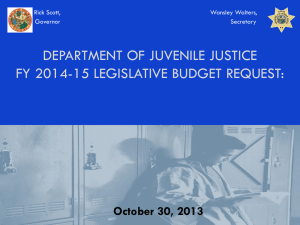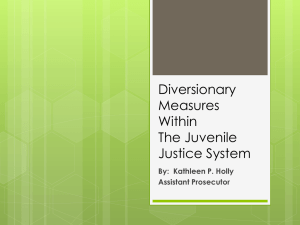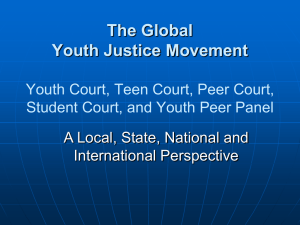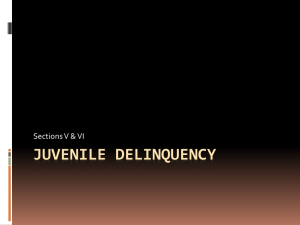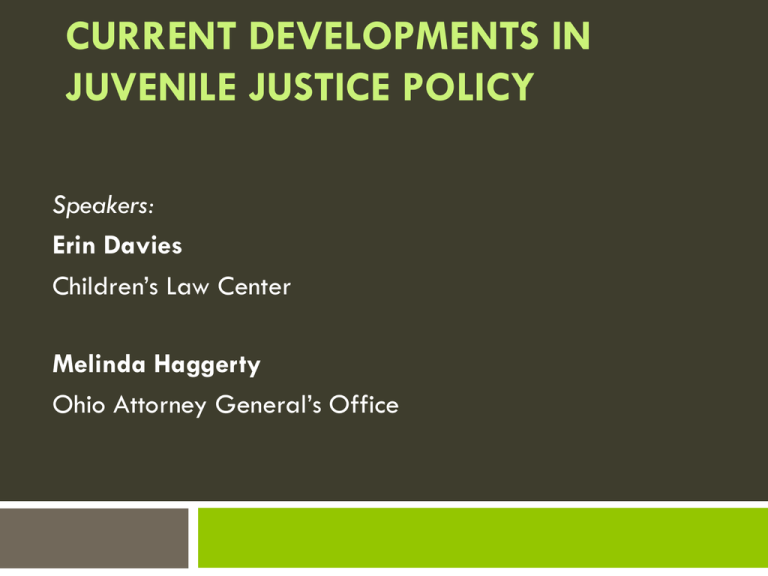
CURRENT DEVELOPMENTS IN
JUVENILE JUSTICE POLICY
Speakers:
Erin Davies
Children’s Law Center
Melinda Haggerty
Ohio Attorney General’s Office
Overview: Ohio’s Juvenile Justice
System
Juvenile Court 101:
Purpose of Juvenile Court
Hold youth accountable and keep the
public safe, while recognizing the
fundamental developmental
differences between youth and adults.
Juvenile Court 101:
Goal of Juvenile Justice Reforms
Moving toward a “right sized” system
that ensures an individually tailored,
evidence-based appropriate response
for each youth.
Juvenile Court 101:
Terminology
Adult Term
Juvenile Term
Found guilty Adjudicated
delinquent
Sentence
Disposition
Jail
Detention
Prison
Probation
Correctional
institution
Probation
Parole
Parole
Definition
Court determines you committed an
offense
Punishment for committing an
offense
Pre-trial or shorter-term post-trial
secure placement
Post-trial secure placement
Part of sentence/disposition for
committing crime
Conditional early release from a
locked facility
National Research- and EvidenceBased and Trends
Moving Away From:
Placing youth in locked
facilities
Moving Towards:
Community-based programming
alternatives
One-size-fits-all approach
Assessing youth’s individualized
needs and appropriate responses
“Gut feelings” about what
works or what youth need
Utilizing evidence- and researchbased assessments and programs
Focusing on the youth and his Examining the underlying root causes
or her offense
for court involvement
National Research- and EvidenceBased and Trends: Benefits
More cost-effective
Proven to work effectively to reduce
recidivism, increase rehabilitation, and
improve public safety
Community-based
More appropriate given youths’ unique
developmental needs
National Research- or Evidence- Based
Trends: Status Offenders
Moving Away From:
Detaining status offending
youth, including for their own
protection
Solely addressing the youth
and his or her offense
Formally processing status
offending youth in courts
Youth being pushed from
schools into jj (aka school-toprison pipeline)
Moving Towards:
Placing youth in community-based
programming
Addressing the underlying root
causes of the offense (family issues,
education needs, etc.)
Diverting youth from the juvenile
court system, including into other,
more appropriate systems (i.e. child
welfare or mental health)
Addressing youth behavior in the
school setting (i.e. PBIS, restorative
justice)
National Research- or Evidence- Based
Trends: Delinquency Offenders
Moving Away From:
Moving Towards:
Placement in juvenile
correctional facilities
Incentivizing courts to place youth in
community-based alternatives
Long sentences in juvenile
correctional facilities
Shorter-term sentences in
correctional facilities, if at all
Focusing on the youth and the
offense
Addressing root causes for behavior
(i.e. trauma, substance abuse, mental
health needs)
Minimizing the long-term impacts of
juvenile court involvement
Long-term collateral
consequences (i.e. sex offense
registration)
National Research- or Evidence- Based
Trends: Youth in Adult Court
Moving Away From:
Prosecuting youth in adult court
Moving Towards:
Retaining youth in juvenile court,
including through blended sentencing
Placing youth in adult jails and
prisons
Placing youth in juvenile detention
and correctional facilities
Potential for mandatory transfer
and extreme sentences,
including death and life without
parole
Same court rules and standards
for youth and adults
Individualized transfer assessments,
sentencing, and meaningful release
review
Accounting for developmental
differences between youth and
adults, including in courts and
facilities
Ohio Juvenile Justice System: Trends
Away From:
Towards:
Ohio Examples:
Placing youth in locked Community-based
facilities
programming
alternatives
Detention – JDAI
DYS - RECLAIM, Targeted RECLAIM, BHJJ,
MST, early DYS release, decreased
mandatory gun specs, detention credit
Prosecuting youth in
adult court
One-size-fits-all
approach
Keeping youth in
juvenile court
Assessing youth’s
individualized needs
and tailored responses
Reverse waiver, jail removal
“Gut feelings” about
what works or what
youth need
Utilizing evidence- and
research-based
assessments and
programs
OYAS, JDAI, Targeted RECLAIM, BHJJ, 45%
reallocation budget language, MST
Long-term collateral
consequences
Minimizing collateral
consequences
Early sealing/expungement
OYAS, early DYS release, gun
specifications, mental health taskforce, MST
Ohio Juvenile Justice System:
Legislative Changes
HB 86 – Reduced mandatory gun specification time, allowed
judges to release youth from DYS facilities early, created
reverse waiver, and established mental health taskforce and
competency guidelines
SB 337 – Allowed youth to receive detention credit and to
more easily seal and expunge their juvenile court records,
placed youth in juvenile detention instead of adult jails
Budget – Increased allocations to Targeted RECLAIM and BHJJ,
45% of savings from facility closures can be allocated to
evidence-based programs
Ohio Juvenile Justice System:
Programs
Program name:
Purpose:
Results:
OYAS
Instrument to assess youth’s
needs/risks at each point of the
juvenile justice system
Provides objective, risk-based
recommendations to juvenile
courts
JDAI
Ensure only youth who are a threat to Detention reductions in 5
the community are detained pre-trial counties averaging 27%
RECLAIM and
Targeted RELCAIM
Direct youth away from DYS and into Lower recidivism rates; over
community-based programs
50% reduction in DYS facility
(Targeted RECLAIM requires the
populations
program to be evidence-based)
BHJJ
Provides evidence-based, communitybased programs for youth with
serious mental health or substance
abuse needs
Increased school attendance,
reduced out of home
placement, decreased
substance use and recidivism
Ohio Juvenile Justice System:
Program Acronyms
Acronyms:
JDAI – Juvenile Detention Alternative Initiative
RECLAIM - Reasonable and Equitable Community and
Local Alternatives to the Incarceration of Minors
Targeted RECLAIM – evidence-based version of
RECLAIM
OYAS – Ohio Youth Assessment System
BHJJ- Behavioral Health Juvenile Justice Initiative
MST – Multi-Systemic Therapy
Attorney General’s Task Force on
Criminal Justice and Mental Illness
Taskforce: What Is It?
Designed to address the “revolving door” of
individuals with mental health issues who come to
the attention of the juvenile or adult criminal justice
system
Co-Chaired by Former Ohio Supreme Court Justice
Stratton and Attorney General DeWine
Evolved from the Advisory Committee on Mental
Illness and the Courts (ACMIC)
Advisory Committee on Mental Illness
and the Courts
Originally founded in 2001
Run by the Supreme Court of Ohio
Accomplishments:
37
mental health courts
Promoted training for over 4,500 CIT officers
Advocated for new Juvenile Competency statute
Challenge: Confined to issues impacting the Courts
Taskforce: Subcommittees
Aging
Diversion and reentry
Housing
Juvenile justice
Law enforcement
Mental health and the courts
Policy and legislation
Psychiatry and Treatment
Research/Best Practices
Veterans Courts and Military Affairs
Taskforce: Who is Involved?
State agency representatives
Law enforcement
Judges
Mental health practitioners
Advocates
Individuals with direct system experience
Taskforce: Juvenile Justice
Subcommittee Participants
Co-Chaired by a representative from the Attorney
General’s Office and Franklin County Juvenile Court
Judge Beth Gill
Members include advocates, practitioners,
representatives from the Ohio Supreme Court and
the Department of Youth Services, and individuals
directly impacted by the system
Taskforce: Juvenile Justice
Subcommittee Overview
Monthly meetings to discuss current issues in juvenile
justice in Ohio
Speakers from throughout the state to keep
members up to speed on the latest trends in counties
Three sub-groups: prevention/diversion, data
collection, and youth involved in the juvenile or adult
criminal justice systems
Taskforce: Juvenile Justice
Prevention/Diversion
Focused on early identification of children with
trauma or mental health issues and getting them into
services before they hit the juvenile justice system
Examples:
Red
Flags Program
School Responder Program
Taskforce: Prevention/Diversion
Accomplishments
Issue: As recent events have shown, mental health
programs can be critical to maintaining school
safety.
Initiatives: The Subcommittee has weighed in with
the various Ohio initiatives on school safety by
promoting the School Responder System, which is in
place in several counties in Ohio and helps to
identify mental health issues in school early before
the youth becomes involved with the juvenile system.
Taskforce: Prevention/Diversion
Accomplishments
School Responder Program
MacArthur
Foundation “Model for Change”
Trains teachers, bus drivers, cafeteria staff, janitors, and
other school professionals on how to recognize mental
health issues
Places “responder” in school to link child to mental
health services
Currently operating in Summit County and Jackson
County
Taskforce: Prevention/Diversion
Accomplishments
Summit County
80 youth served
(2011)
76% had improved
attendance, behavior,
and had mental health
issue addressed
Jackson County
First year: over 200
youth served, only 8
entered the JJ system
School referrals
decreased by 1/3
Taskforce: Prevention/Diversion
Accomplishments
After Sandy Hook shootings, Senator Lehner and
Senator LaRose held series of school safety hearings
JJ Subcommittee advocated for School Responder
Model to promote early identification of mental
health issues prior to a violent incident
Taskforce: Juvenile Justice
Data Collection
Focus on getting better data collection system on
youth in the juvenile justice system
Currently, all 88 juvenile courts use several different
court software systems
Ohio law requires annual reports
Need data to drive evidence-based policies
How
can we know if a program is working if we don’t
have data?
Taskforce: Data Collection
Accomplishments
Issue: Ohio is one of the few states that does not
have a comprehensive, uniform data collection
system for youth involved in juvenile courts, including
youths’ mental health needs.
Initiative: The Subcommittee compiled a list of
juvenile justice system data points for the Ohio
Supreme Court to consider, provided research on
other states’ data collection systems
Served
as a catalyst
Taskforce: Juvenile Justice
System-Involved Youth
Focus on youth who are involved in either the
juvenile justice or adult criminal justice systems
Ensure that they are given access to mandated,
age-appropriate mental health resources and
education
Particular concerned with youth in adult jails
Bindover,
SYO
Taskforce: Youth in Juvenile Detention
Accomplishments
Issue: Youth who enter juvenile detention centers in
Ohio do not receive uniform screening for mental
health issues, which can affect the youth’s stay.
Initiative: The Taskforce awarded DYS $82,500 to
implement a statewide standardized screening
process for Ohio's juvenile detention centers and
public child service agencies. DYS is currently moving
forward with implementing the MAYSI-2, a juvenile
mental health screening tool, in detention centers
across Ohio.
Taskforce: Juvenile Justice
System-Involved Youth
Youth in Adult Jails
36 times more likely to commit
suicide
Often experience periods of
isolation
American Academy of Child
and Adolescent Psychiatry:
creates depression, anxiety,
and psychosis
Jails unequipped to provide
youth with proper education
or youth-trained mental health
services
Youth in Adult Prisons
8 times more likely to
commit suicide
5 times more likely to
be sexually assaulted
Almost twice as likely
to be attacked with a
weapon by inmates or
beaten by staff
Taskforce: Youth in Adult Court
Accomplishments
Issue: Youth in Ohio can be held in adult jails, which
can create or exacerbate mental health issues for
youth, especially when held in isolation.
Initiatives: The Subcommittee 1) sent out a survey to
jails to examine under what circumstances youth are
held in jails and 2) worked to change Ohio’s jail
standards to include youth-specific information.
Taskforce: Youth in Adult Court
Accomplishments
Issue: Youth sentenced to life sentences can face
difficult gaining parole, despite the fact that they
are developmentally different from adults.
Initiatives: The Subcommittee has proposed youthspecific guidelines for the parole board to consider
when determining whether to release a youth.
Taskforce: Accomplishments Beyond
Juvenile Justice
Awarded additional grants, including to:
Provide crisis counseling in two counties’ jails and
crisis prevention in two Ohio veteran’s homes
Provide trainings to first responders on elder abuse
Provide a curriculum for peer mentors in veterans’
courts
Increase rental subsidy program for individuals in
mental health courts






